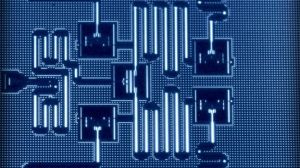 |
| Quantum computers wait in wings as Moore's Law slows to a crawl. Source: IBM |
Fair to say our sister blog turned into "The Saturday
Evening Review of John Markhoff" a long time ago. Well, at Amazing Techno Futures, the news feeds are
good - and we could do worse than to track John Markhoff, who has been covering
high tech at NYTImes for lo these many years. And I will not turn into a pumpkin if I hijack my own hijack of John.
For your consideration: His May 5 article on Moore's Law.
He rightly points out this at inception was more an observation than a law, but
Intel's Gordon Moore's 1965 eureka that the number of components that could be
etched onto the surface of a silicon wafer was doubling at regular intervals
stood the test of what today passes for time.
The news hook is a decision by the Semiconductor Industry
Assn's to discontinue its Technology Roadmap for Semiconductors, based I take
it on the closing of the Moore's Law era. IEEE will take up where this leaves
off, with a forecasting roadmap [system] that tracks a wider swath of
technology. Markhoff suggests that Intel hasn't entirely accepted the end of
this line.
Possible parts of that swath, according to Markhoff, are
quantum computing and graphene. The heat of the chips has been the major
culprit blocking Moore's Law further run. Cost may be the next bugaboo. So far,
parallelism has been the answer.
Suffice it to say, for some people at least, Moore's Law
has chugged on like a beautiful slow train of time. With the Law in effect
people at Apple, Sun, Oracle, etc. could count on things being better tomorrow
than they were today in terms of features and functionality. So the new future,
being less predictable, is a bit more foreboding.
I had my uh-ha moment on something like this in about
1983 when I was working on my master's thesis on Local Area Networks. This may
not completely be a story about Moore's Law.. But I think it has a point.
Intel was working at the time to place the better part of
the Ethernet protocol onto an Ethernet controller (in total maybe it was a
5-chip set). This would replace at least a couple of PC boards worth of
circuitry that were the only way at the time to make an Ethernet node.
I was fortunate enough to get a Mostek product engineer
on the phone to talk about the effect the chip would have on the market - in
those days it was pretty much required that there were alternative sources for
important chips, in this case Mostek. The fella described to me the volume that
was anticipated over 5 or so years, and the pricing of the chip over that time.
I transcribed his data points to a graph paper, and, as the volume went up, the
price went down. Very magical moment. - Jack Vaughan
No comments:
Post a Comment